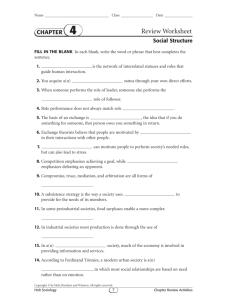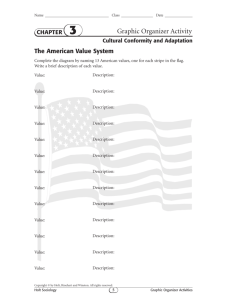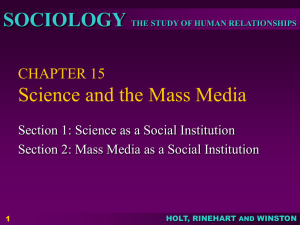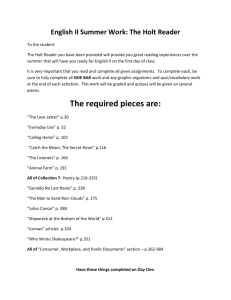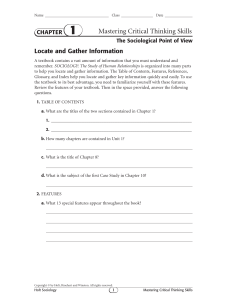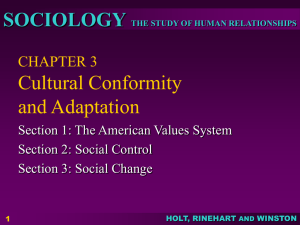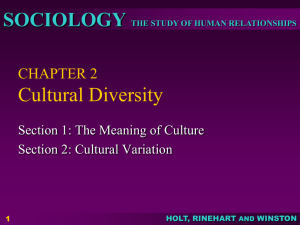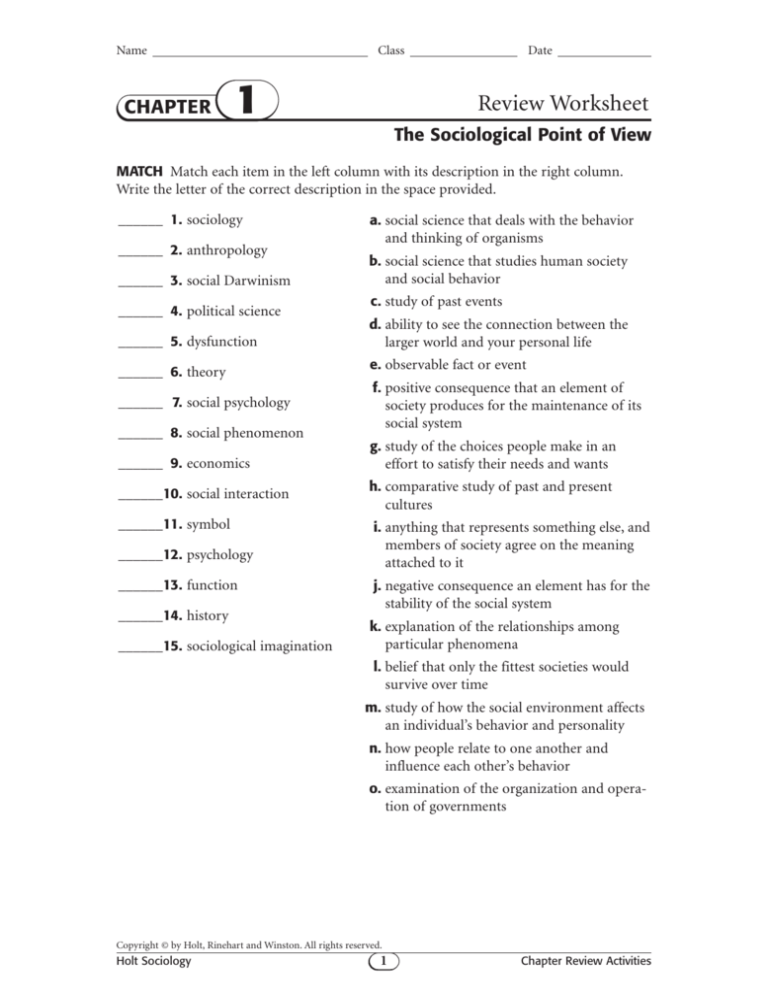
Name
CHAPTER
Class
1
Date
Review Worksheet
The Sociological Point of View
MATCH Match each item in the left column with its description in the right column.
Write the letter of the correct description in the space provided.
______ 1. sociology
______ 2. anthropology
______ 3. social Darwinism
______ 4. political science
______ 5. dysfunction
______ 6. theory
______ 7. social psychology
______ 8. social phenomenon
______ 9. economics
______10. social interaction
______11. symbol
______12. psychology
______13. function
______14. history
______15. sociological imagination
a. social science that deals with the behavior
and thinking of organisms
b. social science that studies human society
and social behavior
c. study of past events
d. ability to see the connection between the
larger world and your personal life
e. observable fact or event
f. positive consequence that an element of
society produces for the maintenance of its
social system
g. study of the choices people make in an
effort to satisfy their needs and wants
h. comparative study of past and present
cultures
i. anything that represents something else, and
members of society agree on the meaning
attached to it
j. negative consequence an element has for the
stability of the social system
k. explanation of the relationships among
particular phenomena
l. belief that only the fittest societies would
survive over time
m. study of how the social environment affects
an individual’s behavior and personality
n. how people relate to one another and
influence each other’s behavior
o. examination of the organization and operation of governments
Copyright © by Holt, Rinehart and Winston. All rights reserved.
Holt Sociology
1
Chapter Review Activities
Chapter 1, Chapter Review Activities, continued
SHORT ANSWER Answer the questions in the space provided.
16. How did the Industrial Revolution change European society?
17. Describe the beliefs of Karl Marx about the structure and operation of society.
18. Describe the interactionist perspective and give three topics to which this perspective
is typically applied. _____________________________________________________
19. Which theoretical perspective should you use? Explain.
Copyright © by Holt, Rinehart and Winston. All rights reserved.
Holt Sociology
2
Chapter Review Activities
(ANSWER KEY)
Chapter 1
interactionist perspective is used to study
topics such as child development, relationships within groups, and mate selection.
19. Each theoretical perspective presented in
this chapter poses different questions, and
provides contrasting insights into, the social
world. Combining the elements each has to
offer will provide you with a more complete
understanding of human behavior.
THE SOCIOLOGICAL POINT OF VIEW
1. b
9. g
2. h
10. n
3.1
11. i
4. o
12. a
13. f
5.j
14. c
6. k
7. m
15. d
8. e
16. The Industrial Revolution brought rapid
social and political changes to Europe.
The rural economy of farms and cottage
industries gave way to an economy based
on large-scale production. The factory
replaced the home as the main site for
manufacturing. With the growth of factories came the growth of cities, as people
left their homes in the countryside in
search of work. The rapid growth of
urban populations produced many social
problems, such as housing shortages,
crime, and pollution. Urban life was different from life in small rural communities, where interactions were based on
close personal relationships.
Chapter 2
CULTURAL DIVERSITY
1. culture
8. Values
9. Norms
2. material
10. expectations
3. nonmaterial
4. Society
11. folkways
5. norms
12. dynamic
13. complex
6. shared
7. grammar
14. patterns
15. George Murdock examined hundreds of
different cultures in an attempt to determine what general traits are common to
all cultures.
16. Murdock argued that in all cultures, the
purpose of the family is the same. The
family ensures that new members will be
added to society and cared for until old
enough to fend for themselves. In addition, the family introduces children to the
components of their culture.
17. Margaret Mead was trying to determine
whether differences in basic temperament—the fundamental emotional disposition of a person—result mainly from
inherited characteristics or from cultural
influences.
18. The Arapesh are contented, gentle, nonaggressive, receptive, trusting, and warm
people. Their society is based on complete
cooperation. The Mundugumor are
aggressive, competitive, jealous, and violent, and show open hostility among all
members of the same sex.
19. Arapesh children grow up in a very loving
and friendly social environment. Babies
arc tended when they cry and spend much
of their time being held by someone. They
are taught consideration and respect for
17. Marx believed that the structure of a
society is influenced by how its economy
is organized. According to Marx, society is
divided into two classes—the bourgeoisie,
or capitalists, and the proletariat, or workers. The bourgeoisie own the means of
production. The proletariat own nothing
but provide the labor needed to produce
goods and services. Marx believed that the
power imbalance among these groups
would inevitably lead to class conflict. The
proletariat would overthrow those in
power and create a classless society.
18. The interactionist perspective focuses on
how individuals interact with one another
in society. Sociologists who adopt this
perspective are interested in the ways in
which individuals respond to one another
in everyday situations. They also are
interested in the meanings that individuals
attach to their own actions and to the
actions of others, and particularly in the
role that symbols play in interactions. The
Copyright © by Holt, Rinehart and Winston. All rights reserved.
Holt Sociology
37
Chapter Review Activities


